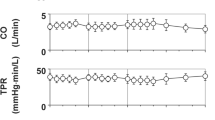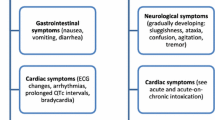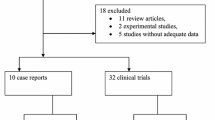Abstract
Lithium is one of the classical drugs that have been widely used for treating bipolar disorder. However, several cardiac side effects including sick sinus syndrome, bundle branch block, ventricular tachycardia/fibrillation, non-specific T-wave abnormalities in addition to Brugada-type electrocardiographic changes have been noticed in patients who were given antidepressant, anticonvulsant, and/or antipsychotic drugs besides lithium. In this study, we assessed cardiohemodynamic and electrophysiological effects of lithium carbonate by itself to begin to analyze onset mechanisms of its cardiovascular side effects. Lithium carbonate in intravenous doses of 0.1, 1, and 10 mg/kg over 10 min was cumulatively administered with an interval of 20 min to the halothane-anesthetized beagle dogs (n = 4), which provided peak plasma Li+ concentrations of 0.02, 0.18, and 1.79 mEq/L, respectively, reflecting sub-therapeutic to toxic concentrations. The low and middle doses prolonged the ventricular effective refractory period at 30 min and for 5–30 min, respectively. The high dose decreased the heart rate for 45–60 min, delayed the intraventricular conduction for 15–20 min and the ventricular repolarization at 45 min, and prolonged the effective refractory period for 5–60 min. No significant change was detected in the other cardiovascular variables. Thus, lithium alone may have a wide safety margin against hemodynamic adverse events; however, it would directly and/or indirectly inhibit Na+ and K+ channels, which may synergistically increase the ventricular refractoriness from the sub-therapeutic concentration and decrease the heart rate at the supra-therapeutic one. These findings may partly explain its clinically observed various types of arrhythmias as well as electrocardiographic changes.




Similar content being viewed by others
References
DeBattista, C. (2015). Antipsychotic agents & lithium. In B. G. Katzung & A. J. Trevor (Eds.), Basic & clinical pharmacology (13th ed., pp. 490–509). New York: McGraw Hill Education.
Yap, Y. G., Behr, E. R., & Camm, A. J. (2009). Drug-induced Brugada syndrome. Europace, 11, 989–994.
Darbar, D., Yang, T., Churchwell, K., Wilde, A. A., & Roden, D. M. (2005). Unmasking of brugada syndrome by lithium. Circulation, 112, 1527–1531.
Wright, D., & Salehian, O. (2010). Brugada-type electrocardiographic changes induced by long-term lithium use. Circulation, 122, e418–e419.
Sugiyama, A. (2008). Sensitive and reliable proarrhythmia in vivo animal models for predicting drug-induced torsades de pointes in patients with remodelled hearts. British Journal of Pharmacology, 154, 1528–1537.
Johannesen, L., Vicente, J., Mason, J. W., Sanabria, C., Waite-Labott, K., Hong, M., et al. (2014). Differentiating drug-induced multichannel block on the electrocardiogram: randomized study of dofetilide, quinidine, ranolazine, and verapamil. Clinical Pharmacology & Therapeutics, 96, 549–558.
Cao, X., Nakamura, Y., Wada, T., Izumi-Nakaseko, H., Ando, K., & Sugiyama, A. (2016). Electropharmacological effects of amantadine on cardiovascular system assessed with J-Tpeak and Tpeak-Tend analysis in the halothane-anesthetized beagle dogs. The Journal of Toxicological Sciences, 41, 439–447.
Van de Water, A., Verheyen, J., Xhonneux, R., & Reneman, R. S. (1989). An improved method to correct the QT interval of the electrocardiogram for changes in heart rate. Journal of Pharmacological Methods, 22, 207–217.
Linakis, J. G., Savitt, D. L., Schuyler, J. E., Simon, P. M., & Raymond, R. M. (2000). Lithium has no direct effect on cardiac function in the isolated, perfused rat heart. Pharmacology & Toxicology, 87, 39–45.
Descotes, J., Lievre, M., Rouzioux, J. M., Faucon, G., & Evreux, J. C. (1978). Cardiac electrophysiological effects of lithium gluconate in anesthetized dogs. Therapie, 33, 661–670; (in French).
Abdel-Zaher, A. O., & Abdel-Rahman, M. M. (1999). Lithium chloride-induced cardiovascular changes in rabbits are mediated by adenosine triphosphate-sensitive potassium channels. Pharmacological Research, 39, 275–282.
Mamiya, K., Sadanaga, T., Sekita, A., Nabeyama, Y., Yao, H., & Yukawa, E. (2005). Lithium concentration correlates with QTc in patients with psychosis. Journal of Electrocardiology, 38, 148–151.
Alvarez, P. A., & Pahissa, J. (2010). QT alterations in psychopharmacology: proven candidates and suspects. Current Drug Safety, 5, 97–104.
Acknowledgements
The authors thank Ms. Misako Nakatani and Mrs. Yuri Ichikawa for their assistance during preparation of the manuscript.
Funding
This study was supported in part by JSPS KAKENHI Grant No. JP16K08559 and AMED Grant No. JP17am0101122.
Author information
Authors and Affiliations
Corresponding author
Ethics declarations
Conflict of interest
The authors indicated no potential conflict of interest.
Ethical Approval
All experiments were approved by the Toho University Animal Care and User Committee (No. 17-54-275) and performed in accordance with the Guidelines for the Care and Use of Laboratory Animals of Toho University.
Additional information
Handling Editor: Kurt J. Varner.
Rights and permissions
About this article
Cite this article
Goto, A., Nakamura, Y., Lubna, N.J. et al. Analysis of Safety Margin of Lithium Carbonate Against Cardiovascular Adverse Events Assessed in the Halothane-Anesthetized Dogs. Cardiovasc Toxicol 18, 530–536 (2018). https://doi.org/10.1007/s12012-018-9464-0
Published:
Issue Date:
DOI: https://doi.org/10.1007/s12012-018-9464-0




